
Projecting climbing routes isn’t widely taught, so how do you learn this complicated art? Here's our beginner's guide.
The post Never Had a Project Before? Here’s Where to Start. appeared first on Climbing.
]]>
I take climbing seriously. I’ve lived the dirtbag lifestyle, chased El Cap dreams, and been a gym rat. I’ve climbed many pitches of frozen waterfalls and embarked on remote alpine routes. I’ve prioritized climbing over relationships and put pebble wrestling above family. Yet I still don’t know how to project a route. Not only have I never memorized every move of a route and devoted weeks or months to its completion; I have never even had the motivation to work on a single route beyond a handful of tries.
Frankly, I’m jealous of my grade-motivated peers who target certain routes and work them until they succeed; not only do they tend to progress faster through the sport, they seem to find more purpose in their climbing, which motivates them to put their heart and soul into each project. I meanwhile find it comfortable and easy to “train” by simply going into my local gym and climbing as hard as I can each session; but I’m frustrated by the plateau I’ve been stuck in for years. And I’d bet my #5 Camelot that most climbers are in the same boat.
Which got me wondering: Why don’t I project? And why do so few climbers learn this specific skill? What’s the secret?
Is there a secret to projecting?
Nathan Hadley, a software developer, 5.14 climber, first ascensionist, and all-around crusher, understands why more climbers don’t take up projecting.
“Being able to intuit how to read something is really rewarding,” he told me. He enjoys trying to onsight and flash routes, finding flow in climbing without rehearsing moves, and knowing that he can climb a wider variety of routes if he doesn’t spend as much time on an individual route—and he thinks that’s why most climbers don’t project much, myself included. (Why spend an inordinate amount of time on one route when there are so many routes to climb?!)
But Hadley also recognizes that to climb his hardest, he needs to spend significant time on a route—honing the beta and muscle recruitment, and getting stronger by doing harder moves. “There is more potential to climb that upper limit [through projecting],” he said.
Ally Cruz, the head routesetter at Edgeworks Climbing in Tacoma, Washington, has similar motivation for projecting routes. Climbing 5.12 was a barrier for her in the past, something that felt intimidating and out of reach. But the process of working harder routes made the grade feel more attainable over time, said Cruz. Now that she’s seen her effort pay off, she finds herself trying to convince her coworkers that trying harder things—and accepting that success won’t come easy—can change their climbing and adjust their sense of their own limits.
As a North American Ice Climbing Champion, rock climber, and elite dry tooler , Kevin Lindlau knows a lot about the art of projecting. For him it requires time, commitment, and a very analytical approach to climbing. Before he even touches rock, he tries to watch videos of other climbers sending his proj, giving him an idea of the movement and the possible cruxes of the route—a method that proved particularly useful when working his dream route, A Line Above the Sky (D15) in the Italian Dolomites, during a short trip from his hometown of Bozeman, Montana. (Some context: D16 is currently the world’s hardest dry tooling grade.)
When I asked him how I might start projecting, Lindlau told me to begin by thinking of a route that got me stoked. “Find something that inspires you,” he said, “so you don’t get burnt out or give up.” He also said it was important to find different goals, both long-term and short-term. “Find a dream route and then backtrack to find mini goals,” he said. “A lot of people go for their dream project [first] and get burnt out.”
Hone your process
Talking to each of these climbers, it became clear that, once you’ve identified a route that you’re psyched on, finding a process is essential. There is no right or wrong way to work a route, though there are common methods that projectors follow. Hadley likes to “give it a good [first] effort from the ground, even if I know I don’t have a chance,” while Lindlau likes to suss out the route and touch all the holds before he even starts to climb. After he gets comfortable with how the holds feel, Lindlau gets into the nitty gritty. “After figuring out where all the holds are, I’ll draw the whole route on paper with arrows on it with direction of pull.” He will then go bolt to bolt and try to physically do the moves. “I’ll stop at a crux and rest and then do another sequence. I’ll do that move three or four times.” After a day or two of going up the route and getting comfortable, he’ll take a rest day and then give it a redpoint try.
When he isn’t physically trying the route, he uses visualization tactics to memorize the sequence and get him in the right head space. “Once an hour I’ll go through the movement [in my head],” Lindlau said.
Hadley echoes the importance of learning a route. “You have to memorize the route. You don’t have an excuse not to,” Hadley said. He has seen too many climbers blow their send, not because they couldn’t do the moves, but because they forgot the beta.
Practice projecting in the gym
As a routesetter, Cruz has a daily pulse on the gym climbing scene. She finds that most members at her gym are “really here to just climb and not to send something.” Her observation resonates with me, as I find myself drawn to the gym for socializing or simply to blow off some steam from a busy workday. As a dedicated projector, Lindlau sees the gym as a place to hone his projecting skills. “Mini projects in the gym can be helpful. It gets you in the right headspace to find out what you need to do when you do go outside,” he said.
So why don’t people project more often?
Because it’s so damn hard. “Projecting is tough mentally because you are trying something at your limit. Each attempt is stressful,” Hadley said. But once you accept that it’s going to be hard, once you acknowledge that sending is not the only metric of success, it can be incredibly rewarding—as I myself have recently discovered.
That’s right: News flash! I found a project, and I’m totally stoked.
Japanese Gardens (5.11+, 4 pitches) is located in Index, WA, and it felt impossible at first. The climb is sustained, very beta intensive, and involves a lot of precise smearing. After my first try, I almost gave up. I’ve climbed the grade before, but I’ve never put together that many hard pitches in one ground-up effort, which is my personal goal. But after speaking with Hadley, Cruz, and Lindlau, I felt ready to employ their tactics, and I’m hoping to discover the joy of really sticking with a route.
I don’t fully know what I’m doing yet, and I’m still winging it, but I’m motivated and more excited about climbing than I’ve been in years. As a father of two kids under three years old, my time is limited, and I need to be focused to find moments to climb. I’m using methods like toprope soloing to work on my project when I have time, instead of relying on the schedules of my partners. I can do all the moves now, and that’s given me hope. I’m not sure I’m ready to call myself “a projector,” but I am smitten by this route, and I’ve discovered a new joy in this way of climbing.
The only thing I’m left wondering; why did it take me so long?
Key Takeaways for the Aspiring Projector
- Pick a climbing project that you are 100% stoked on, not just something you think you should climb because it’s classic or the right grade.
- Figure out a repeatable projecting process that works for you.
- Break down routes into sections and memorize cruxes rather than trying to remember the entire route.
- If you are stuck in a plateau, projecting can help you break out and have fun climbing again.
- Learn to try hard without taking it too seriously; If it’s not fun, you aren’t doing it right!
The post Never Had a Project Before? Here’s Where to Start. appeared first on Climbing.
]]>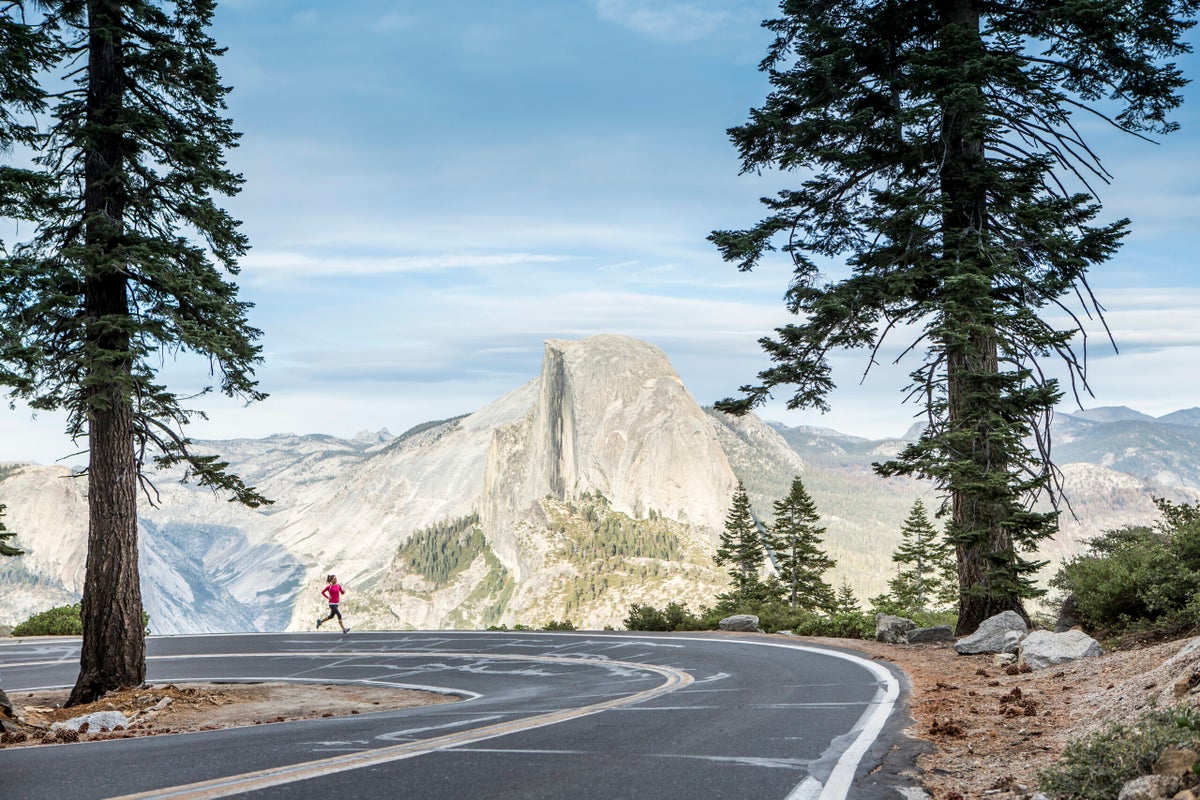
We asked a number of leading trainers. The answer is a resounding "yes"—but also a resounding "no."
The post Should Rock Climbers Incorporate Runs Into Their Training? appeared first on Climbing.
]]>
In a world increasingly full of specialists, the generalists shine through. At least that’s what I like to tell myself. I like nothing more than cruising up splitter cracks and clipping chains. Yet I also love to ski, surf, mountain bike, and trail run. This past winter, I trained for and completed my first 50k trail race, the Chuckanut 50k in Fairhaven, Washington, a mix of flat trail and long, steep climbs, demanding fitness and stamina. Throughout my training, a part of me kept asking why I was spending this much time running when climbing was my priority. In the past, I’d heard that running can hurt climbing performance, but I wasn’t really feeling that way. I knew that time spent running took time away from climbing, but running felt good for my overall fitness and health. I loved how running provided a freeform outlet for both mind and body. During my training, each day of running felt different and new. From running out my door on paved roads, to driving an hour to run trails in the Cascade mountains, and running single track trails in my local park, I felt invigorated by each workout. And so after my race, I sought answers from training experts to find out if running can, contrary to rumor, actually increase climbing performance.
Myths vs. facts
There’s a myth in climbing circles that too much running will make your legs big and heavy. Steve Bechtel, a climbing coach, and founder of the coaching platform Climb Strong, said that it’s very hard and extremely rare to bulk up legs from running. “I don’t see a lot of runners who have gigantic legs. Building muscle mass in lower legs is harder than it seems,” Bechtel said. Instead, he sees many athletes benefit from regular running. “It’s a good way of trying to manage body weight and a great way to build total capacity,” Bechtel said. (Total capacity is essentially the maximum amount of training you can do and still adequately recover from. This helps build long-term fitness.)
Sam Naney, a former professional Nordic skier, founder of Cascade Endurance, and all-around athlete, believes that running can help climbers maintain fitness and will be helpful on a musculoskeletal level. “Running can help you keep a level of impact in your body that can provide good resilience with joints and the surrounding muscles and tendons that support joints,” Naney said. Having resilient joints means your body can hold up to the loads that climbing (and approaches) puts on the body over the long term. While many people complain that running hurts their knees, if done right—say running at a slower pace, with correct footwear, and on flat, varied terrain, and only gradually increasing speed, distance, and elevation—running can actually help maintain musculoskeletal integrity. In other words, if your knees hurt, you’re going too hard: tone it back and progress more gradually.
Mandie Majerus and Mitch Owens are lifelong climbers and physical therapists who specialize in treating climbers and athletes in the Seattle metro region. Both PT’s see huge benefits in their clients who love to climb and run.
“Running can be used as a base to improve a climber’s aerobic capacity,” Majerus said “This can improve the oxygen-carrying capacity of the blood and help climbers develop a reserve. Ultimately, this can translate into managing your heart rate”—which can help on long, multi-pitch climbs or on days that involve longer approaches.
“Running is[also] a great adjunct so you don’t burn yourself out on climbing,” she added, “and has great mental benefits that come into play with the release of endorphins.”
But hold on
But despite these benefits, there are drawbacks to supplementing your training with running. Our bodies only have so much energy for exercise, even if we target different muscle groups. If you are a newer climber looking to quickly progress in the sport, or if you’re an experienced climber who’s pushing their training to the absolute limit, focusing on climbing rather than other forms of training is likely the best use of your time. “Running too much directly before climbing can deplete your blood glycogen which can have a negative effect on your climbing performance that day,” Owens said. “[And] running too much in a given week can overload your optimal training volume, leading to fatigue and decreased immunity.”
Which begs the question, when should you run and climb and when should you stay specialized?
Most of the coaches, PTs, and climbing experts that I spoke to agreed that, in order to be at peak climbing performance, focusing primarily on climbing is key. Bechtel iterates that to perform at a high level at both running and climbing isn’t truly possible; there has to be compromise. “We have a limited capacity for work. It’s possible to improve in both running and climbing but not maximize one or the other,” Bechtel said.
“Running will take away some time from working on the technical aspects of climbing. Therefore, how much time you dedicate to it will depend on your goals,” Majerus adds.
During my training block for my 50k race, I noticed my motivation to maintain climbing strength waned; I just didn’t have the energy to go to the gym and try hard on my days off from running, even as my enjoyment and abilities in trail running flourished. In other words, my climbing did suffer when my focus swung too far away from my primary sport, yet it was worth it to me for a short period of time to reach my race goal. I wasn’t in shape to redpoint my hardest grade, but I was ok with that. I felt like my improved cardio and endurance would help me with some of my alpine climbing goals, allowing me to climb harder routes in the mountains because I might not be as tired from the approach.
And not all running needs to be extreme. Coach Naney notes that running for 30 minutes per day three to four days a week will have musculoskeletal and general fitness benefits but won’t be enough to detract from your climbing goals.
So is running good for climbing or not?
It depends. If you, like me, want to dabble in many outdoor pursuits, enjoying seasons of climbing, running, and skiing, then compromising climbing to pursue other goals might be worth sacrificing climbing gains. I love to alpine climb, and running helps me maintain the requisite full-body fitness. It also helps me maintain a healthy weight, which can help me avoid climbing injuries when I dive more fully into my climbing-specific training cycles. But if you’re training hard five or six days per week, and if climbing the hardest possible grade is meaningful to you, then running probably isn’t all that helpful. “If you’re really banging your head and feeling you’re not ready [to climb your hardest], maybe it’s time to cut away the extra stuff,” Bechtel said. “When you really want to get good, you have to specialize.”
The post Should Rock Climbers Incorporate Runs Into Their Training? appeared first on Climbing.
]]>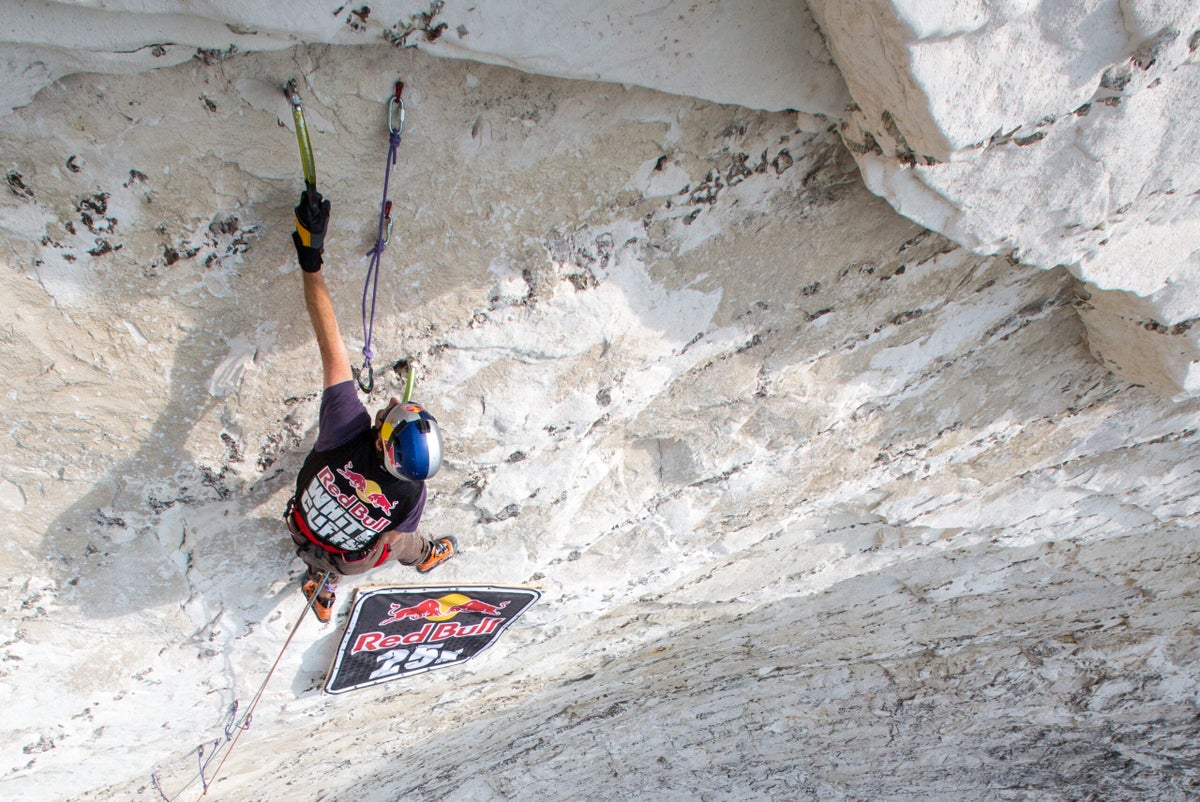
Dry tooling is increasingly popular. Here’s why Will Gadd thinks this unique form of climbing may be the next big thing.
The post Opinion: Why Is Dry Tooling Getting So Popular? It’s Awesome appeared first on Climbing.
]]>
It’s a rainy day in western Washington, typical for November. Between changing my 8-month old’s diapers and a busy work schedule, my time is limited, and I don’t want to waste a precious free day of climbing. The only problem? There is no dry rock within two hours of my house, and the fickle ice in the Cascades hasn’t formed yet. Not wanting to spend another day stuck inside the bouldering gym, a lightbulb goes off in my head: it’s time to go dry tooling at Wayne’s World, a newly developed crag just 30 minutes outside of Seattle in North Bend, Washington.
Rain or shine, sleet or hail, dry tooling is accessible no matter the time of year. With more and more crags being developed, fewer crowds than most rock-climbing cliffs, and a season that runs year-round, it’s no surprise (to some of us, anyway) that dry tooling is on the rise.

Dry tooling isn’t just for reaching ice
“The idea of climbing with tools on rock seemed completely insane 25 years ago,” professional climber, dry tooling expert, and all-around crusher Will Gadd told me over the phone. What started out as a way to get to ice climbs, has become a discipline of climbing in itself. The sport now has specific gear such as dry tooling boots with built in front points and more durable picks than those used for ice climbing. There is an international competition for dry tooling (though technically called the UIAA Ice Climbing World Tour, the nine competitions during the 2022/2023 season all involve climbing on artificial structures, with very little actual ice climbing). There are even gyms dedicated specifically to dry tooling (check out The Ice Coop in Boulder, Colorado), and many rock climbing gyms now set routes exclusively for dry tooling.
But there’s another reason dry tooling is taking off: It’s a lot of fun. Who doesn’t like wielding sharp objects, slotting thin metal edges into tiny fissures, or making improbable moves like the Stein Pull or figure four?
There’s also a certain element of problem solving involved in dry tooling. “It’s hard to find out how to make it work. It’s hard, so it’s interesting,” Gadd said.
The sport’s intricate movement and technical nature requires its practitioners to develop a unique set of skills. But once these skills are honed, the tools literally come to feel like extensions of your body, giving extra reach, harnessing powerful bi-directional forces, allowing you to make unlikely moves that would be impossible on a pure rock climb.
Dry tooling is accessible
As climate change races forward, the ice climbing season is in many places becoming less predictable and, alas, shorter. Dry tooling is something climbers can do without relying on cold temperatures, though Gadd stressed that ice climbing and dry tooling are two very different sports. “In the public eye it’s the same but they are completely different things.” And just because you know how to use tools, he said, doesn’t mean the skills are transferable across the disciplines.
It’s also safer. While ice climbing is reliant on wintery conditions and often involves traveling into avalanche terrain, dry tooling has relatively little risk (most hard dry tooling routes are basically sport climbs) and their approaches are generally much more straightforward.
One of the keys to the growth of dry tooling is the tremendous potential for route development. There is rock everywhere, from Kansas to Saskatchewan, but that doesn’t mean all rock is sufficiently high quality for rock climbing. But drytooling, rock climbing’s stepchild, is not so picky. “There’s [a seemingly] unlimited supply of rock out there that is great for dry tooling,” Gadd said.
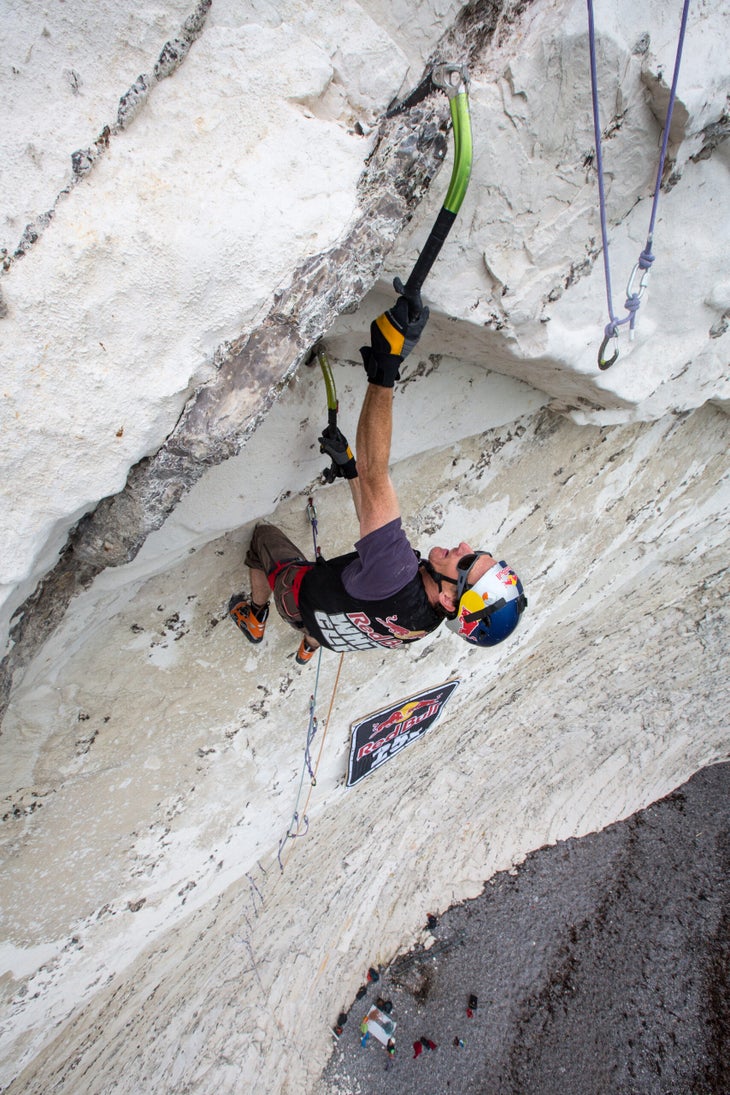
The future of dry tooling is man made
While the future of dry tooling is bright, the ceiling for hard dry tooling on natural rock may have been reached. From a physics standpoint, there is a limit to what the equipment of the sport i.e. the tools and front points can edge on without popping off. Gadd believes that outdoor dry tooling grades will become harder based on pushing the limits of endurance rather than the difficulty of individual moves. And since there just aren’t that many natural climbs that are both humanly possible and harder than anything yet done by a human, Gadd sees the future of dry tooling in competition climbs and climbing on man-made structures.
These manufactured routes often involve “big spans where you cut loose and swing on flat roofs,” Gadd explained. The rising popularity of dynamic routes—routes with features that physically move and swing as you move around on them—adds a new challenge that doesn’t much resemble the moves found on a static piece of rock.
It’s challenges like this that get Gadd excited and convince him that the sport of dry tooling has a bright future. “Who would have thought 25 years ago that this is where it would lead,” Gadd reflected. A dynamic sport that you can do in the rain, all year round, anywhere in the world?
I’m on board.
Out at Wayne’s World, I’m reminded (for the hundredth time) why I love climbing. The shady crag, tucked away from the traffic noise of Interstate 90, feels like a learning ground for all. There are three parties climbing here, and their excitement is palpable, almost like we were discovering a new way of climbing (which some of us were), in a secret location, and getting away with it. Climbers are passing tools with dry rated pics to climbers who only have ice rated pics on their tools. I love the movement and the challenge of climbing routes in a style that feels so familiar, yet so different. Dry tooling that day was scary, engaging, safe, technical, social, and fun—all mixed into one.
And that’s how climbing should be.
The post Opinion: Why Is Dry Tooling Getting So Popular? It’s Awesome appeared first on Climbing.
]]>
Climbers find it hard not to compare ourselves with others, whether in a gym, at the crag, or on Instagram. Learn how to can it. You'll climb better for it.
The post Comparison Can Steal the Fun From Climbing: Quit Judging Yourself appeared first on Climbing.
]]>
The chains! A big grin stretches across my face, and I pump my fist. A wave of pride washes over me as I lower. I’ve finally sent the project I’ve been working on for months. I reach the floor, high five my belayer, and then look up.
Two routes over, James is quietly flowing up the wall, heel hooking and crimping, onsighting a climb I flailed on. My joy vanishes, replaced with frustration and jealousy. I just remembered: My friend is a much better climber.
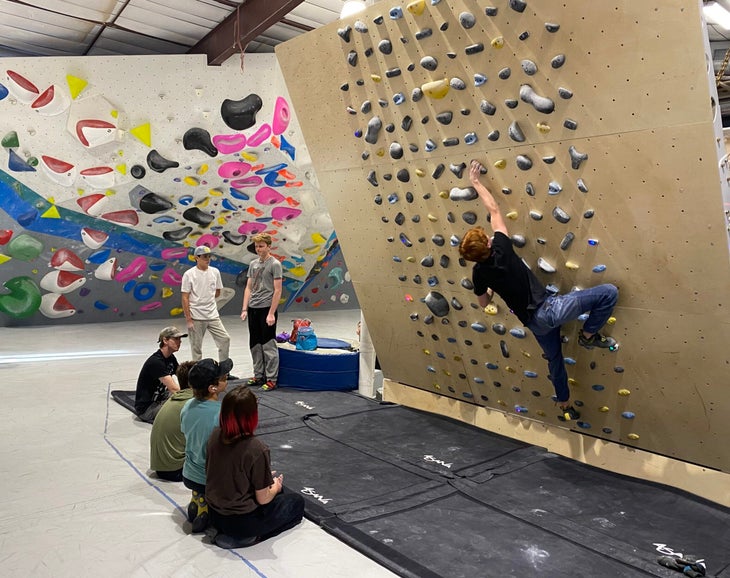
It’s hard for climbers not to compare ourselves with others, whether in a gym, at the crag, or on Instagram. Even the best climbers in the world compare their climbing to that of their peers. It is how we internalize and cope with comparison that keeps climbing fun or puts us under a black cloud.
5.15 Self Critics
Nathan Joyner, the general manager of High Steppe Climbing Center in Yakima, Washington, says that at one time he compared himself more to others, leading him to a dead end. “I had been looking for validation from others and wasn’t getting it,” he says. “To get back to a positive relationship to climbing, I had to reorganize my priorities and restore my motivation.”
But how? When we are bogged down by thoughts of comparison, is it possible to break the cycle?
Michele Lang, the owner of Insight Climbing & Movement on Bainbridge Island, Washington, believes that the best way is by using mindfulness and meditation techniques. Lang starts by analyzing her self-talk, asking, “How am I talking to myself?”—whether, she says, in a considerate or self-loathing way. Through years of climbing and watching her daughter compete at a high level, Lang has found that negative self-talk is widespread in climbing. “We talk to ourselves so much less kindly than we do to others,” she says. We wouldn’t tell our climbing partners that they suck at climbing when they don’t finish climbs, but many climbers tell themselves that.
When she does start to go down the rabbit hole of comparison, Lang focuses on the mindfulness technique of letting go: focusing on her breath, and trying to live in the present moment. That’s just a thought, and doesn’t represent who I am. It was a comparison thought that I can let go.
“We are all 5.15 self-critics,” she says. “I’d rather not create that suffering for myself.”
Manage Comparison
Lang is co-facilitating a six-day mindful climbing retreat at the Deer Park Monastery encouraging climbers to look inward and be fully present in climbing (and life). She points me to self-compassion.org, which is not for climbing per se, but teaches useful general practices for being easier on ourselves and provides exercises that anyone can do.
The tip I found useful right away urges: “acknowledging [my] self-critical voice and reframing its observations in a more friendly way.” Taking that tack, I can say, I gave this route my all, instead of, I suck because I didn’t send. Lang notices that many climbers think they must be hard on themselves to improve, but the opposite is true. When we cease beating ourselves up, she says, it “frees up a lot of that mental bandwidth,” allowing us to climb with fewer constraints.
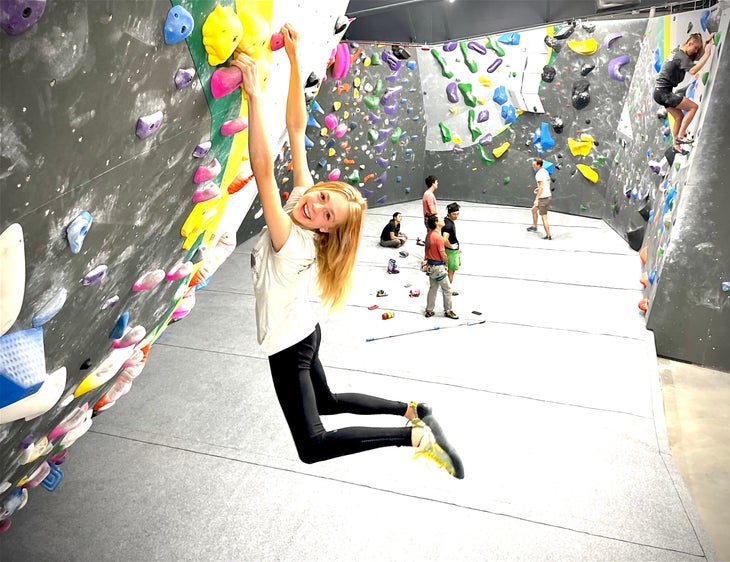
For many youth climbers, comparison is an inherent part of climbing. Layla Alden, a 13-year-old from Truckee, California, puts it bluntly. “I compare myself to my friends,” she says, as if that would be obvious. “I watch them climb and compare my own climbing to theirs.” Layla has been climbing since the age of 2, and now, as a teenager, is more aware of what her peers are doing. Seeing a facile send, she says, “makes me want to do the climb again, and do it more like the person I watched. It doesn’t always make me feel good about my own climbing, though.” Still, she uses comparison as motivation, saying it “inspires me to be the best climber I can.”
Bill Ayre, a youth climbing coach at Vertical World climbing gym in Seattle, finds that the 9-to-15-year-olds he works with may limit their climbing by, as he puts it, “putting barriers in front of themselves. The kids might associate a climb with someone else and say, ‘If they can’t do it, I can’t do it.’ Yet that way of thinking may keep them from trying routes that are within their abilities.”
Focus On Your Performance
As a guide for Alpine Ascents International, also in Seattle, Andrew Bennett is well versed in other climbers’ behavior. Rather than comparing himself to other climbers (and even clients), he finds it useful to look inwards. “Compare yourself to you. How were you climbing three weeks ago, three months ago, or three years ago?” Bennett says.
Tod Bloxham, the owner of Edgeworks Climbing + Fitness based in Tacoma, Washington, echoes this strategy. “I’m competitive against myself, gauging my own marks,” he says. He finds it useful to look at trends “and not focus on a good or bad day.” He also finds that when he looks for routes that he finds interesting and that look fun, he can climb more freely. This approach also leads a climber to choose routes for other reasons than grade.

Madeline Crane, a sport psychologist from Austria and an author on climbingpsychology.com, offers one-on-one coaching sessions for climbers looking to improve on the mental aspects of climbing. In a blog post about social comparison in climbing, she offers tips on how to work through comparison when it becomes detrimental to climbing performance, writing, “Positive affirmations—or self talk—is one of the most powerful mental tools you can have in your mental toolbox.” She continues, “In order for affirmations to work, they need to be accurate and feel right for you. This means, every one of us will find different affirmations helpful.”
Awareness is another tool. “It can also help when you notice that you are comparing yourself to others and feel bad about it,” Crane writes.
Is Comparison Serving You?
Michele Lang tells her young climbers, “Focus on what you can do,” rather than on what others are doing.
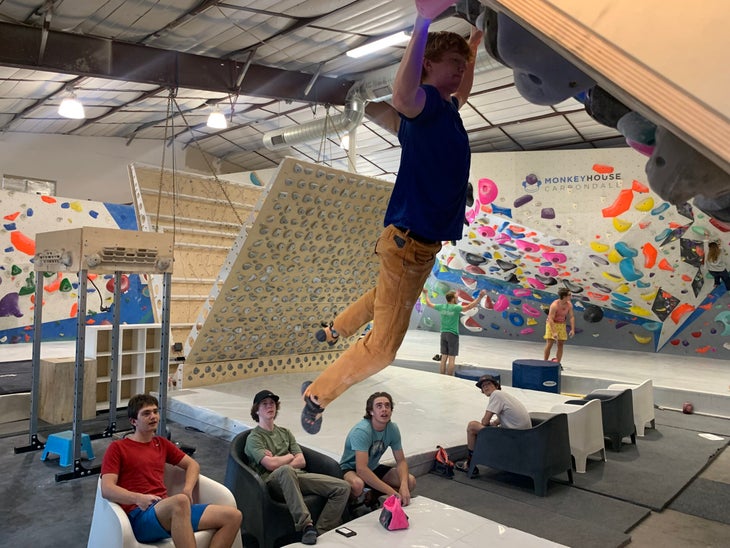
It has taken me years to figure out why I compare myself to my climbing partners, and I’m still working on it. When I measure myself against others, I start to lose interest in climbing, training, and going to the gym. When I climb for myself, because I enjoy the movement, and am still in love with the sport, I’m simply climbing because it’s fun; and in the moment, that is good enough.
Takeaways
Avoid the down sides of comparison by:
- Taking deep breaths and focusing on the present.
- Using positive self-talk.
- Climbing for fun rather than chasing grades.
- Measuring yourself against your past performances and not someone else’s.
Weekend Whipper: Miscommunication Almost Causes Mid-air Collision
The post Comparison Can Steal the Fun From Climbing: Quit Judging Yourself appeared first on Climbing.
]]>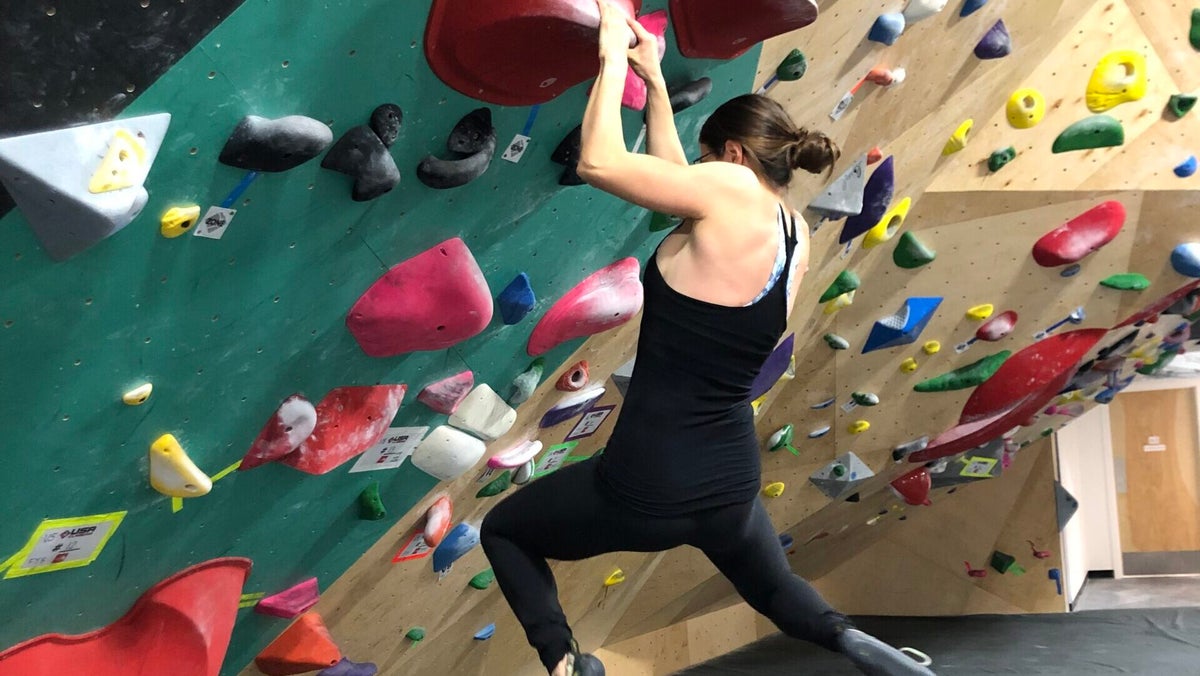
Forced to try the routes after the gym hosted a bouldering competition and left them up for weeks, I found one session reignited my stoke.
The post Five Reasons Why Climbing On Comp Routes Can Make You Better appeared first on Climbing.
]]>
The one-two beat of a climber’s hands slapping a volume rings throughout the gym. The competitor’s legs swing from one side clear to the other, and she nails a heel hook, setting herself up to dyno precisely to the finish.
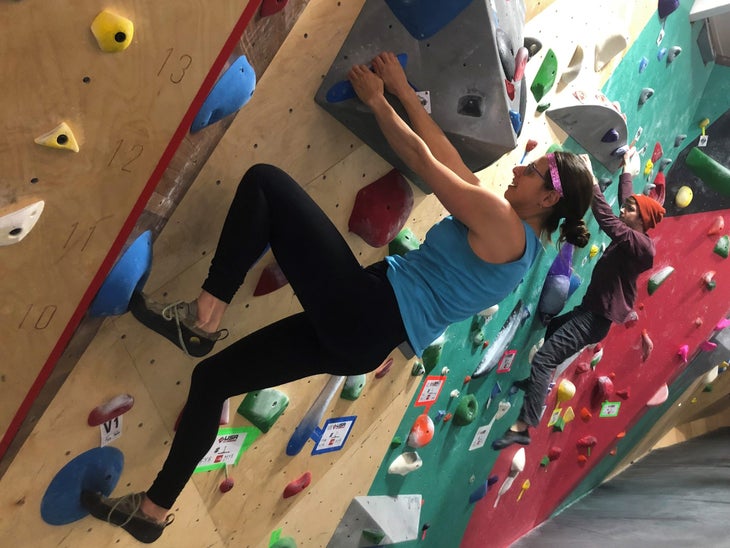
Comp climbing may not look as much like rock climbing as it once did, and is no longer so much about pure strength and athleticism, but problem-solving and creativity as well. Competitors contort, turn upside-down, run lightly across the wall, and jump up or sideways to catch the next hold—and maybe the next. This type of climbing is exciting, dynamic, and fun to watch. But you might think you couldn’t possibly do it.
As someone who has been climbing for nearly two decades, I initially resisted the new style of climbing, which melds elements of parkour and acrobatics with climbing techniques. Thinking I wasn’t flexible enough, was in no way acrobatic, or simply would look stupid, I didn’t touch these problems when they began appearing at my gym. Even the starting footholds were marked—for us to dart up on, which looked overly committing at best. My climbing routine was getting stale, though, and I was feeling slightly bored until forced to try the comp routes after the gym hosted a bouldering competition and left them up for weeks. Just one session reignited my stoke for climbing in the gym: I found joy in jumping for unlikely holds; making novel lateral moves, as if launching off a ramp; utilizing unique features such as giant volumes lined up in a row; or negotiating problems connected solely by slopers.
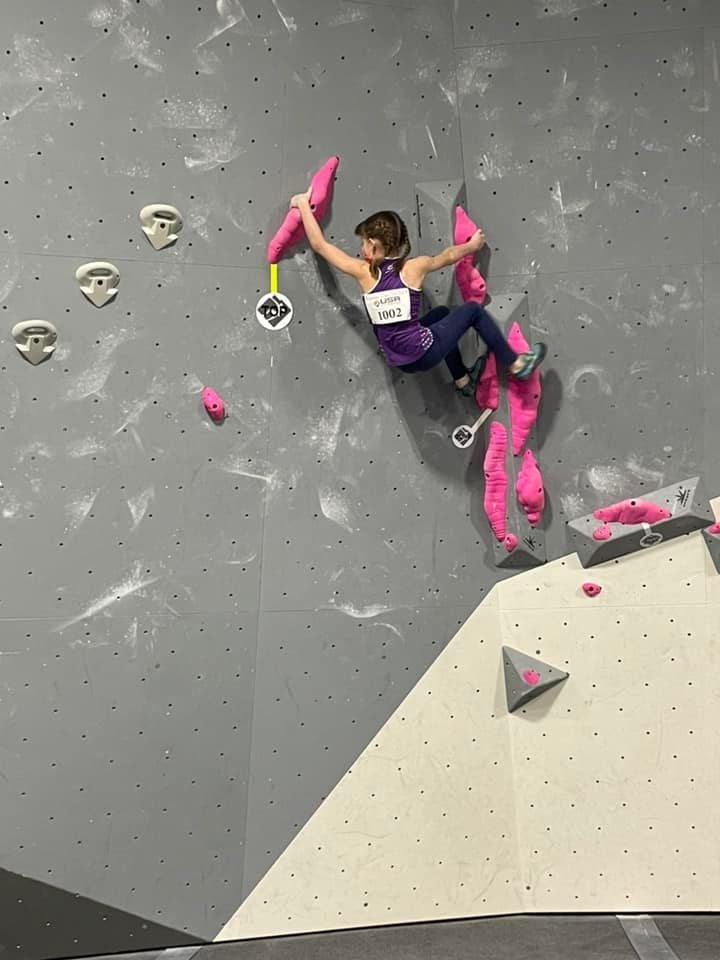
Feeling stuck in your gym routine? Here are five reasons to try climbing on comp routes.
Feel Like a Kid Again
Climbing is supposed to be fun. Young kids in the gym usually aren’t worried about grades or how hard they are climbing, but are there for the joy of it. Swinging from hold to hold as if they were tree limbs or part of a jungle gym, falling in a heap, and leaping without fear, kids are built for comp routes.
Adults can learn this type of climbing, too. Just like pulling in on heel hooks or learning how to crimp, climbing more dynamically and creatively takes practice. With time, you are rewarded with a renewed sense that climbing is playful.
Reimagine What is Possible
If it looks impossible, it probably is? So you thought. Guess again. Comp routes demand that you think about climbing differently, and that is what makes them so intriguing. Holds look impossibly out of reach? Think about using momentum, more than you are used to, to propel yourself rather than climbing statically. The finish is 30 feet to the left of the start with only two holds in between. Be inventive. There are foot chips where your hands would normally be. Try getting upside-down. This type of climbing stretches your creativity. You might have to think outside of the box by taking a zig-zag route to get to the finish rather than going straight up.
This article is free. Please support us with a membership. Join the Climbing team and you’ll not only receive Climbing in print, plus our annual special edition of Ascent, but you’ll enjoy unlimited online access to thousands of stories, news and safety articles.
Avoid Taking Yourself Too Seriously
Bouldering can be intimidating. How often do you walk up to the front of a room full of people, some resting and staring, and try something really hard where you are more than likely to fail or fall? One of the beauties of comp routes, though, is that they are often ridiculous. Everyone trying them is going to feel silly because the problems frequently involve moves we don’t normally make. Even the strongest climber may look a bit strange running sideways along the wall or stemming backwards, facing out, if that is the only way to complete the problem. Comp routes can take us away from worrying about what we look like when we climb; they help us let loose.
Use Different Muscles
When you’ve been crimping, pinching, smearing, edging, and pulling hard repeatedly, specific muscles not only get tired but overused. The free-flowing, energetic nature of comp routes mean they involve different muscles than most routes in the gym. You might use your calves more to make a big jump, tighten your abs to stay on the wall when your feet cut after a huge lateral move, or engage both feet in a toe hook to maintain tension. It may take some time to build the muscle memory and core strength needed for this type of climbing, but just as, somewhere along the line of advanced climbing, you learned to hang on extended rather than flexed arms to save energy, you can absorb these kinds of new moves.
Build Community
One of the most fun parts of bouldering is that it is a social form of climbing. Comp routes use very specific sequences, contrived movements, and distinct features such as a series of rails, larger-than-normal volumes, and widely spaced-out holds, increasing the importance of good beta. These routes can be deciphered so much faster when groups of people figure them out together. You play off each other, pushing higher with each go, reaching, falling, trying hard, flailing, having fun together. Isn’t that the point?
David Gladish is a freelance writer, proud father of two young boys, and lover of adventurous climbing, preferably on perfect Cascade granite on coveted sunny days.
See also this
VIDEO FROM THE VAULT: Sean McColl’s Crazy Moves
…and yes, that will soon be you.
The post Five Reasons Why Climbing On Comp Routes Can Make You Better appeared first on Climbing.
]]>